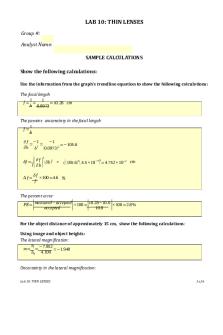Thin-Cylinders - Thin wall cylinder PDF

| Title | Thin-Cylinders - Thin wall cylinder |
|---|---|
| Author | bharath purushothaman |
| Course | Theory Of Elasticity and Plasticity |
| Institution | Anna University |
| Pages | 6 |
| File Size | 227.1 KB |
| File Type | |
| Total Downloads | 5 |
| Total Views | 148 |
Summary
Thin wall cylinder...
Description
Thin Cylinders
Introduction 1 1 When the thickness of the wall of the cylinder is less than 10 to 15 of the diameter of cylinder then the cylinder is considered as thin cylinder. Otherwise it is termed as thick cylinder.
t
P
d
L L=Length of the cylinder d= Diameter of cylinder t = thickness of cylinder P= Internal Pressure due to fluid
Generally, cylinders are employed for transporting or storing fluids i.e. liquids and gases. Examples-: LPG cylinders, boilers, storage tanks etc. Due to the fluids inside a cylinder, these are subjected to fluid pressure or internal pressure (Say P). Hence at any point on the wall of the cylinder, three types of stresses are developed in three perpendicular directions. These are:1. Circumferential Stress or Hoop Stress ( h) 2. Longitudinal Stress ( L) 3. Radial Stress ( r)
Assumptions in Thin Cylinders 1. It is assumed that the stresses are uniformly distributed throughout the thickness of the wall. 2. As the magnitude of radial stresses is very small in thin cylinders, they are neglected while analyzing thin cylinders i.e. r=0
Stresses in Thin Cylinder 1. Circumferential Stress ( h):- This stress is directed along the tangent to the circumference of the cylinder. This stress is tensile in nature. This stress tends to increase the diameter.
The bursting in the cylinder will takes place if the force due to internal fluid pressure(P) acting vertically upwards and downwards becomes more than the resisting force due to circumferential stress ( h) developed in the cylinder. Total diametrical Bursting force= P * Projected area of the curved surface =P*d*L Resisting force due to circumferential stress= 2 *
h* t * L
Under equilibrium, Resisting force = Total diametrical Bursting force 2* Circumferential stress,
h* t * L = P * d * L
Pd
h = 2t
2. Longitudinal Stress ( L) :- This stress is directed along the length of the cylinder. This stress is also tensile in nature. This stress tends to increase the length.
Π 2 4 *d Area of crossection where longitudinal stress is developed= Π * d * t
Total longitudinal bursting force (on the ends of cylinder) = P *
Resisting force due to longitudinal stress = L * Π * d * t Under equilibrium, Resisting force = Total longitudinal Bursting force Π
L * Π * d * t = P * 4 * d2
Longitudinal stress,
Pd
L = 4t
Note:- Due to the presence of longitudinal stress and hoop stress, there is shear stress developed in the cylinder. Maximum in-plane shear stress is given by
(τmax)inplane =
h2
L
=
Pd 8t
Strains in Thin Cylinder 1. Strain in longitudinal direction ,
εL =
h
Pd (1- 2µ) εL = 4tE
Longitudinal strain =
2. Strain in circumferential direction,
3.
L
E –µ E
εh = Eh –µ
L E
Circumferential strain =
Pd (2- µ) εh= 4TE
Volumetric strain =
Pd (5-4µ) εv= 4tE
Where µ = Poisson’s ratio E= Modulus of Elasticity
For Objective Questions 1. (a) Major principal stress= Hoop stress or circumferential stress ( h) (b)Minor principal stress= Longitudinal stress ( L) 2. If
(
t
is the permissible stress for the cylinder material, then major principal stress
h) should be less than or equal to h≤
t
Pd 2t ≤
t
t≥
Pd 2
t
t.
3. In order to produce pure shear state of stress in thin walled cylinders, L)
h=–
4. Maximum shear stress in the wall of the cylinder (not in-plane shear stress) is given by :
τmax =
h 2
=
Pd 4t
5. In case of thin spherical shell, longitudinal stress and circumferential stress are equal and given by
L=
Pd
h = 4t (tensile)
(τmax)inplane =
References 1. Mechanics of Materials by B.C. Punmia 2. Strength of Materials by SS. Rattan
h2
L
=0...
Similar Free PDFs

Experiment 6 - Thin Cylinder
- 30 Pages

363659998 Thin Cylinder Report
- 19 Pages

Thick cylinder
- 14 Pages

Thin Layer Chromatography Report
- 5 Pages

Cylinder lab - Lab report
- 2 Pages

Lab 10 thin lenses
- 6 Pages

TLC - Thin Layer chromatography
- 4 Pages

Lab #1 Thin Layer Chromatography
- 13 Pages

Breskvar v Wall
- 9 Pages

Micro wall street 1
- 2 Pages

Anterior Abdominal WALL
- 16 Pages

BEKISTING DINDING(WALL FORM
- 70 Pages

Counterfort Retaining WALL MCN
- 12 Pages
Popular Institutions
- Tinajero National High School - Annex
- Politeknik Caltex Riau
- Yokohama City University
- SGT University
- University of Al-Qadisiyah
- Divine Word College of Vigan
- Techniek College Rotterdam
- Universidade de Santiago
- Universiti Teknologi MARA Cawangan Johor Kampus Pasir Gudang
- Poltekkes Kemenkes Yogyakarta
- Baguio City National High School
- Colegio san marcos
- preparatoria uno
- Centro de Bachillerato Tecnológico Industrial y de Servicios No. 107
- Dalian Maritime University
- Quang Trung Secondary School
- Colegio Tecnológico en Informática
- Corporación Regional de Educación Superior
- Grupo CEDVA
- Dar Al Uloom University
- Centro de Estudios Preuniversitarios de la Universidad Nacional de Ingeniería
- 上智大学
- Aakash International School, Nuna Majara
- San Felipe Neri Catholic School
- Kang Chiao International School - New Taipei City
- Misamis Occidental National High School
- Institución Educativa Escuela Normal Juan Ladrilleros
- Kolehiyo ng Pantukan
- Batanes State College
- Instituto Continental
- Sekolah Menengah Kejuruan Kesehatan Kaltara (Tarakan)
- Colegio de La Inmaculada Concepcion - Cebu


